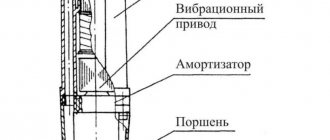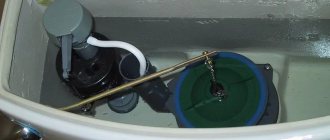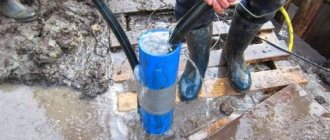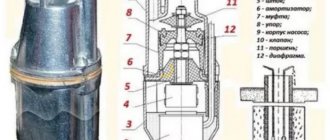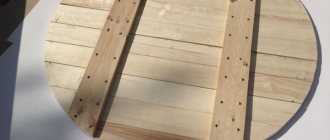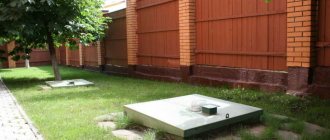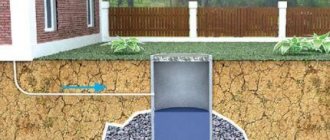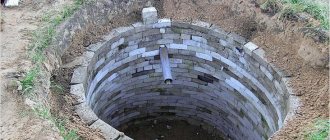A cesspool is a homemade storage tank for sewage with or without a bottom. Such a container needs pumping and maintenance no less than a factory septic tank. Many homeowners are faced with a problem when the cesspool quickly fills up, what to do in this case, the Plumber Portal website will tell you. After all, without the outflow of wastewater, life in a private house will be practically paralyzed.
Why does a cesspool fill up quickly after pumping?
The design of the cesspool assumes that wastewater penetrates the soil through the bottom or its walls. Over time, the liquid does not seep into the ground and fills the entire hole. This happens because the soil has lost its filtering ability. There are several reasons that caused this.
Solids accumulate at the bottom of the cesspool. They must be removed periodically after pumping out the liquid. If this is not done, a dense layer will form, blocking the path of liquid runoff into the soil.
Another probable reason for the formation of a buffer between the liquid and the soil is the low activity of bacteria that do not have time to process organic matter.
This happens in several cases:
- little organic matter in the pit;
- a lot of chemicals harmful to microorganisms are discharged;
- The drains are cold, the temperature is not conducive to bacterial activity.
Tire cesspool.
A common reason why a hole quickly fills with liquid is due to the high content of soap scum and grease in the drains. The substances form a dense film on the bottom and walls, preventing liquid from passing through. This sediment even clogs sewer pipes, preventing drainage.
A preventative measure that prevents an undesirable phenomenon is the installation of grease traps. Folk remedies include weekly flushing of pipes with boiling water or soda and vinegar.
It may be that the volume of the receiver is not sufficient to accommodate all the wastewater. This happens when calculations are incorrect. According to the rules, the septic tank must accept water flow for 3 days. If the capacity is less than the volume of wastewater received during this time, it does not have time to go into the soil. Perhaps the number of residents has been added or additional plumbing fixtures have been installed, but the volume remains the same.
The next reason for the tank to overflow is due to errors in the construction of the pit and poor insulation. If the bottom of the cesspool is above the freezing point of the soil, in winter a crust forms on it, which does not allow liquid to pass through.
Ice may appear in an uninsulated pipe and interfere with the movement of drains.
Recommendations for the effective operation of an autonomous sewer system
For convenient year-round operation of an autonomous sewer system, the established requirements must be observed both at the installation stage and during use:
- Sewer pipes must be laid at a certain slope, the external pipeline must be laid below the soil freezing level or with effective thermal insulation measures.
- The septic tank must be reliably insulated.
- The volume of the cesspool or septic tank must be sufficient to serve a certain number of family members.
- A necessary measure is the periodic introduction of biological products with anaerobic bacteria, limiting the entry of aggressive detergents and cleaning substances into the sump.
- Regular cleaning with equipment capable of cleaning the bottom and walls with a jet supplied under pressure.
Restoring the absorption capacity of the soil
If water does not leave the septic tank, flush it so that the soil begins to filter the liquid again. All contents are pumped out and the pit is filled with clean water. Allow to stand for a day, trying during this time not to discharge wastewater containing chemicals, especially those containing chlorine.
The next stage is the introduction of live bacteria. These are catalysts for natural decomposition processes occurring in any storage or treatment facility. There are natural microorganisms there, but the processing speed is insufficient. The introduction of artificially grown bacteria accelerates the decomposition of organic matter.
In this case, it is necessary to liquefy solid sludge, which prevents liquid from penetrating into the soil. It is partially washed away by fresh, clean water, but the main work is done by microorganisms. They eat old sediment, the remains of which can be removed after processing by bacteria.
Priming.
There are many biological products on the market for different purposes. Septic Shock Bioforce is recommended for liquefying solid sludge. The additives contained in the product contribute to the rapid development of bacteria, which are released into the septic tank. The container is designed for a volume of 1 m³.
Doctor Robik 509 is a product with a similar effect, the packaging is also 1 liter, but enough for 2 m³ of capacity. The drug has a winning price - about 600 rubles. per bottle instead of 900 rubles. for a similar product Septic Shock Bioforce.
In the future, fermentation is constantly maintained with the drug Doctor Robik 409. The bottle is designed for 2 m³, the drug is administered at a wastewater temperature above +4ºС. Use according to the manufacturer's instructions.
All bacteria, including artificial ones, are classified as aerobic and anaerobic. The former live only in the presence of air, so the cesspool must be ventilated. Anaerobics do not need oxygen, but their degree of wastewater purification is lower. Any of these bacteria are not suitable for restoring the absorption capacity of soil at low temperatures - they live at +4...+30°C.
What to do if a septic tank with a closed bottom silts up
The bottom part also silts up in a septic tank with a sealed bottom. Precipitation reduces the usable volume. The phenomenon occurs when the activity of bacteria is greatly reduced due to their insufficient number. The number of colonies decreases under unfavorable factors.
The main ones:
- There is a high concentration of chlorine, alkali and acids in wastewater, which destroy living microorganisms. Substances enter together with preparations for cleaning, washing and washing.
- Fresh wastewater is rarely discharged - there is not enough food for bacteria. If wastewater from the toilet or kitchen is sent to another treatment facility, and water enters the pit only after washing, bacteria will not survive in such conditions.
- The structure is poorly insulated, the temperature of the liquid in it is less than +4ºС. Constantly draining warm water saves the situation, but if this does not happen, the bacteria die.
When the consistency of the wastewater resembles sour cream without separation into liquid and solid fractions, microorganisms cannot cope with their task. Artificially grown ones are introduced, which are contained in biological preparations, such as Doctor Robik 509, Septic Shock Bioforce, Vodogray, Microbec, etc. Those intended for cesspools are used.
If dietary supplements do not help, then the products will not cope with the task. It is necessary to limit the use of household chemicals. Bacterial preparations process sludge and fats, even toilet paper, producing compost and liquid. As a result, there is less waste and the pit is pumped out less frequently. After the septic tank is restored to working order, biological products are regularly introduced into it.
Septic tank with a closed bottom.
If a drainage pump is available and there is running water, use the flushing method. Pump out liquid and sludge. Connect a hose from the water supply and direct the stream to the sediment. The water washes them away, and the contents are pumped out again. The option gives results if the sludge has hardened slightly.
In addition to these methods, chemical methods are used. In a pit with an open or closed bottom, nitrate oxidizers and ammonium compounds can be used without fear of consequences. The use of formaldehyde is allowed only in a sealed cesspool.
When these drugs get into the ground, they destroy all plants within a radius of 10 m.
Removing grease and soap residue
Roetech K-87.
Natural cleansing of a cesspool is possible if fats and soap scum do not get into it along with the drains. At outside temperatures they harden and clog the pores of the soil and sewer pipes.
The liquid does not go through the formed film into the soil, which lacks absorbent capacity. The problem appears sooner or later if the sewer system is not equipped with a grease trap.
They are combated by erosion using biological or chemical means.
Preparations that process soap and fat well:
- Roetech K-87 - the bottle is designed for 1 m³ of wastewater, decomposes fats, soap and organic matter;
- Drainage Comfort from BIOFORCE - use 1 sachet per 10 liters of water to clean clogged sewer pipes;
- Doctor Robik 809 - frees the pit and pipes from soap deposits.
In practice, cleaning using biological products is carried out as follows:
- The liquid is pumped out of the pit and filled with clean water. If it is from a city water supply, let it sit to get rid of chlorine.
- Drugs in the dose recommended by the instructions are poured through sinks and toilets.
- Start using sewerage. Monitor whether productivity has improved. If necessary, repeat the cleaning.
Biological products along the way decompose deposits in the pipes and continue to act in the tank. Microorganisms that break down fats and soap are periodically introduced into it.
Effective methods for preventing sewerage problems
In order to ensure the efficiency of sewerage in a private area and to avoid rapid filling of the drainage pit, it is necessary to follow the operating rules. The following preventive measures must be taken:
- flush the storage tank under strong pressure at least once every one and a half to two months;
- pump out sewage from the pit in a timely manner;
- use biologically active drugs to prevent blockages;
- When laying a hole and designing a sewerage system, due attention should be paid to thermal insulation, which will reduce the risk of freezing of the storage tank.
Compliance with these simple preventive measures, as well as the use of biological products, will allow owners of private houses to maintain the sewer system on their site in ideal condition for many years.
Related materials:
- sewer pumping.
We arrange the removal of clarified wastewater
If the pit is constantly overflowing and cannot cope with the increased amount of waste, then radical measures are taken:
- install a container with a larger capacity;
- an additional tank is connected in series;
- arrange a filtration well or drainage field.
The latter option is more profitable: the storage tank turns into a septic tank, which clarifies the wastewater.
Drainage well
To build a drainage well, dig a shaft up to 4 m deep until sand appears. The structure is built without a bottom or with a perforation system on the walls. Often used together. The bottom is covered with a layer of crushed stone - this is a natural filter with a thickness of 20 to 30 cm. The walls are made from any available materials: car tires, bricks, reinforced concrete rings. They should be airtight, but holes can be made or left for additional filtration.
What is a drainage well?
Both containers are connected by an overflow pipe with a diameter of 110 mm. They can withstand a slope of 2 cm per 1 linear line. m. Now mechanical cleaning occurs in the first chamber - heavy particles fall to the bottom. The liquid flows through the pipe into the next container, where it becomes clarified and goes into the soil.
Filter field
This is a large-scale construction that requires a lot of space. Consists of perforated pipes buried in the ground. They take out the soil to a depth of 1-1.5 m and fill it with 25 cm of sand and crushed stone cushion. Pipes are laid on top, then sand and crushed stone again. The structure is covered with a layer of soil.
8 m of perforated pipes are required to ensure the recycling of wastewater from 1 person. Filtration fields occupy a large area, to reduce it, pipes are laid parallel. To move wastewater by gravity, adhere to a slope of 25 mm per 1 linear line. m.
Drain pit is part of an autonomous sewer system
To collect household and household waste, a storage tank is required, which must be emptied regularly using special equipment. This is usually a large container or structure buried in the ground.
The sizes and shapes of cesspools may vary, but some components must be present in all designs:
- tank , the volume of which corresponds to the needs of the home owners;
- drain inlet through which sewage flows into the tank;
- technical hatch necessary for control and maintenance;
- ventilation pipe that removes harmful gases to a safe height.
Ventilation is often neglected, leaving a hole or gap for air to penetrate inside, or even completely sealing the hole. This is wrong: the unpleasant smell of gases at a certain concentration is also dangerous.
There are still outdoor toilets called “birdhouses” that completely replace country sewer systems: they are both a latrine and a storage area for food waste
Anyone who feels discomfort from walking in the morning chill has long ago installed a full-fledged sewer network. It includes connections to the toilet, sinks, bathtub or shower, and a pipeline connecting points inside the house to a buried reservoir nearby.
The minimum “dacha” set that allows you to regularly wash and keep your house clean is a toilet + shower + sink in the kitchen. Accordingly, the sewer system inside the building connects the plumbing fixtures.
The outer part of the system is a pipe from the wall of the house to the storage tank. A straight and relatively short pipe (but according to SNiP standards no shorter than 5 m) is an ideal scheme for moving wastewater.
The simplest diagram of a country sewer system with a drainage pit. An obligatory addition is the arrangement of a road - an entrance for a sewage truck
Sometimes it is necessary to install complex communications connecting several hoses, for example, to drain wastewater from a house, bathhouse, garage or summer kitchen. But in this case, instead of a regular drainage pit, a septic tank is installed, which, in addition to collecting and storing it, also purifies the water, and then discharges it into the ground (well, ditch) for further treatment.
